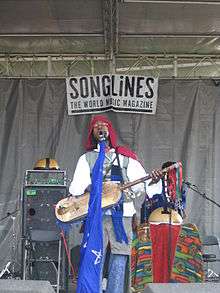Sintir
The sintir (Arabic: سنتير), also known as the Guembri (الكمبري), Gimbri or Hejhouj, is a three stringed skin-covered bass plucked lute used by the Gnawa people. It is approximately the size of a guitar, with a body carved from a log and covered on the playing side with camel skin. The camel skin has the same acoustic function as the membrane on a banjo. The neck is a simple stick with one short and two long goat strings that produce a percussive sound similar to a pizzicato cello or double bass.

.jpg)
The goat gut strings are plucked downward with the knuckle side of the index finger and the inside of the thumb. The hollowed canoe shaped wooden body resonates a percussive tone created by knuckles slapping the camel neck top of the body while the thumb and index finger are plucking the strings. The lowest string on the sintir is a drone note and the second string, the highest in pitch, is tuned an octave higher and is never fretted. The third string is tuned a fourth above the drone. The buzzing sound often heard emanating from the sintir is caused by metal rings dangling off of a galvanized metal feather mounted on the end of the sintir's neck. The feather and rings vibrate in rhythm with the sintir.
The body of the instrument is hollowed out from a single piece of wood, and covered with camel skin. The long neck passes through the top of the body and runs under the face, coming out through the skin near the base of the instrument, to serve as a tailpiece or string-carrier. The sliding leather tuning rings and the rattle-like metal sound modifier are commonly found in such West African instruments as the kora and the xalam (lute). The percussive playing style is reminiscent not only of West African technique but also of certain styles of American banjo picking.
As the sintir is used mainly by Gnawa (North Africans of Sub-Saharan African descent), it is likely that the instrument derives from similar skin-covered lutes of the region around Mali or other areas of the Sahel (such as the ngoni, xalam, or hoddu).
Styles
Sintirs are usually applied to different styles of music:
Tagnawit: is the music of the Gnawa people. The Guembri they use is the biggest: a long body rectangular in shape. There is a hole in the skin at the bridge area for enhanced acoustics. Three strings are used, two that reach the end of the neck, and one that reaches the middle. The two strings are tuned in fourths and are fixed to the circular neck using a special knotting. How the strings stay in tune is a mystery that only the Gnawa hold the secret for. The shorter string, which is also thinner, is tuned like the lowest string and is considered a drone string. Depending on the area where the Gnawa Zaouia (shrine) is located, there are different keys to the tuning. The most common ones however are C, F, D and G. When the Gnawa are clapping and not playing with the Krakebs (a form of castanets), it is not uncommon to add a piece of metal that rings when the Guembri is played (Sersar). The plucking of the strings is done with the thumb and/or the index, and sometimes the player hits the body under the strings for a percussive sound. The Gnawa player who plays with the Guembri is called the Maalem, Master of Ceremonies. The Gnawa also refer to the Guembri as Hajhouj or Sintir. The most popular Guembri players in traditional and popular music are Abderhmane Paco, Mahmoud Gania, Mustapha Baqbou, Hassan Hakmoun,[1] Hajjoub Soudani, and Hamid al Kasri.
Izlan s Tamazight: sung poetry by the Berbers of the Middle Atlas and High Atlas. It has a body the size of a lute or mandolin, but the neck is usually longer and thicker. Unlike the Gumebri of Gnawa, this one has wooden tuners. There are usually four strings (although five is not unusual) tuned in fourths as well. Common tunings are A standard or C standard. It is played similar to a lute, however it has its own tonal range, scales and key progressions that are particular to the Berbers. The main artist plays the lute and sings, accompanied by bendir players and backing singers which can include both men and women. To the Berbers, this type of Guembri is more widely known as Loutar. Popular Loutar players are Mohamed Rouicha, Hammou Oulyazid, Hajjaoui and Maghni.
Malhoun: sung poetry in Moroccan colloquial Arabic (Darija). It is similar to Lotar in shape, but much smaller in size. It is not used as the main string instrument; rather it is used to provide timbre contrast to the music. It is sometimes called Gounibri as well.
References
- Beres, Derek (14 December 2014). "The Master Returns: Hassan Hakmoun & the Electric Sintir at the Heart of Unity". Morocco World News.
External links
| Wikimedia Commons has media related to Guembri. |